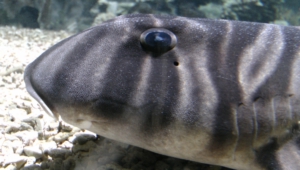

Squalus tigrinus was described by Forster in 1781, two years before Squalus fasciatus was described by Hermann. This name was omitted in Compagno's review in 1984, possibly due to confusion over its year of description (in a publication in 1941, Fowler mistakenly listed it as being described in 1795). A taxonomic review in 2019 instead argued that S. varium are currently in usage for this species until the early 1990s most authorities used the latter name, but since then most have followed Compagno and used the former name. In Compagno's view, the first proper usage of "varius/m" was by Garman in 1913, making it a junior synonym. In 1984, Compagno rejected the name "varius/m" in favor of "fasciatus/m" for the zebra shark, because Seba did not consistently use binomial nomenclature in his species descriptions (though Squalus varius is one that can be construed as a binomial name). Müller and Henle placed this species in the genus Stegostoma in 1837, using the specific epithet fasciatus (or the neuter form fasciatum, as Stegostoma is neuter while Squalus is masculine) from an 1801 work by Bloch and Schneider. No type specimen was designated, though Seba included a comprehensive description in Latin and an accurate illustration of a juvenile. The zebra shark was first described as Squalus varius by Seba in 1758 (Seba died years earlier the publication was posthumous). There is evidence that its numbers are dwindling.Įarly taxonomists thought that juvenile zebra sharks were a different species because of their different appearance from adults. The World Conservation Union has assessed this species as Endangered worldwide, as it is taken by commercial fisheries across most of its range (except off Australia) for meat, fins, and liver oil. Innocuous to humans and hardy in captivity, zebra sharks are popular subjects of ecotourism dives and public aquaria. The zebra shark is oviparous: females produce several dozen large egg capsules, which they anchor to underwater structures via adhesive tendrils. Though solitary for most of the year, they form large seasonal aggregations. At night, they actively hunt for molluscs, crustaceans, small bony fishes, and possibly sea snakes inside holes and crevices in the reef. Zebra sharks are nocturnal and spend most of the day resting motionless on the sea floor. This species attains a length of 2.5 m (8.2 ft). Young zebra sharks under 50–90 cm (20–35 in) long have a completely different pattern, consisting of light vertical stripes on a brown background, and lack the ridges. Adult zebra sharks are distinctive in appearance, with five longitudinal ridges on a cylindrical body, a low caudal fin comprising nearly half the total length, and usually a pattern of dark spots on a pale background. It is found throughout the tropical Indo-Pacific, frequenting coral reefs and sandy flats to a depth of 62 m (203 ft). The zebra shark ( Stegostoma tigrinum) is a species of carpet shark and the sole member of the family Stegostomatidae. Squalus pantherinus Kuhl & van Hasselt, 1852 It's believed that asexual reproduction is more likely to happen in a tank where there are only females, and Aqua World Oarai's zebra shark is the third case of parthenogenesis in the world that occurred for a fish kept in the same tank as a male.Scyllia quinquecornuatum van Hasselt, 1823 Tokunaga says parthenogenesis can occur in sharks when small cells known as "polar bodies" produced during meiosis of the base cells for the egg play the role of sperm. A DNA test confirmed that the baby shark was produced through parthenogenesis. While eggs that are produced via parthenogenesis are less likely to hatch compared to those that go through a regular breeding process, the aquarium successfully hatched the egg by maintaining the water temperature at 26-27 degrees Celsius while adding fresh, cold seawater. Unable to confirm mating between the two, the aquarium suspected that it could be a case of asexual reproduction. The black-and-white striped pattern unique to young zebra sharks is only visible for about a year, and it's expected to change to a brown-dotted pattern as the fish grows.Īccording to Kotaro Tokunaga, who is in charge of the sharks at the facility, the female zebra shark laid an egg in the fall of 2022 while being kept with a male fish. It has been on display as part of the fifth-floor exhibition at the aquarium since March 4. An adult zebra shark with a leopard pattern.


 0 kommentar(er)
0 kommentar(er)
